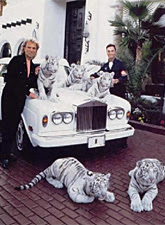 In response to inquiries after a previous blog entry, Macrocosmos and Microcosmos, this article discusses white tiger breeding and their conservational value.
In response to inquiries after a previous blog entry, Macrocosmos and Microcosmos, this article discusses white tiger breeding and their conservational value. First a quick history: white tigers are very rarely found in the wild. In about 100 years only 12 wild white tigers have been seen in India but they have long been a source of myth. They instill a sense of beauty and awe but folklore calls them an omen of death so while they are idolized by some, they are savagely hunted by others. This was the fate of one tiger, named Mohan, who was captured as a cub in 1951 by a Maharajah and his hunting party. Mohan was caged and was destined to father a significant portion of the world’s captive white tiger population.
Since the dramatic characteristics of white tigers are the result of a rare and recessive gene, all white tigers in zoos now are the descendents of Mohan or a other captive orange tigers whose recessive genes showed up through breeding programs. White tigers now represent a grossly disproportionate part of the captive tiger population compared to the natural world. The natural rarity of these animals and pressure from zoos and collectors to produce more white tigers means that current captive breeding pools go back to only a few closely interbred individuals.
"The white tiger controversy among zoos is a small part ethics and a large part economics. Owners of white tigers say they are popular exhibit animals and increase zoo attendance and revenues as well.”
- Dr. Ron Tilson, Conservation, Director of the Minnesota Zoo and Manager of the Tiger Species Survival Plan
Most genetic defects are recessive and so are masked by normal genes but with persistent inbreeding, genetic problems are amplified and accumulated resulting in disabilities and high mortality rates. Dr. Daniel C. Laughlin (Consultant for Big Cat Rescue) estimates that 80% of white tiger cubs die from birth defects associated with the inbreeding necessary to cause a white coat.
Of those surviving, most have profound birth defects, such as strabismus (cross eyes), retinal degeneration, cleft palates, scoliosis of the spine, clubbed feet, immune deficiency, and kidney abnormalities. This means that only a small percentage are suitable for display and are poor performers and so after the great expense and effort spent on breeding them, they cannot all be used for their intended purpose. In addition to the phyical problems associated with these animals there are also mental impairments such as depression and unpredictable behaviour.
 The world’s most famous white tigers performed in Siegfried & Roy flamboyant Las Vegas show at The Mirage. The long-running closed its doors when one of the tigers attacked Roy Horn in 2003. The tigers are still housed at The Mirage who continue to use them as a tourist attraction.
The world’s most famous white tigers performed in Siegfried & Roy flamboyant Las Vegas show at The Mirage. The long-running closed its doors when one of the tigers attacked Roy Horn in 2003. The tigers are still housed at The Mirage who continue to use them as a tourist attraction. “Siegfried & Roy have dedicated their lives to preserving these rare animals, and their efforts have helped save them from total extinction.
- The Mirage, Las Vegas website
The Mirage gives the impression that white tigers are a race that needs to be conserved. The public is generally unaware of the strains on the captive tiger population and to use white tigers as a poster child of conservation is an abuse of the public’s faith. Conservation is occurring of a ‘non species’ white tigers survive in the wild but only in extremely small percentage, as long as we preserve a diverse range of the more ordinary orange tiger we will preserve the white tiger.
"The Tiger Species Survival Plan has condemned breeding white tigers … they serve no conservation purpose."
- Dr. Ron Tilson, Conservation, Director of the Minnesota Zoo and Manager of the Tiger Species Survival Plan




Comments